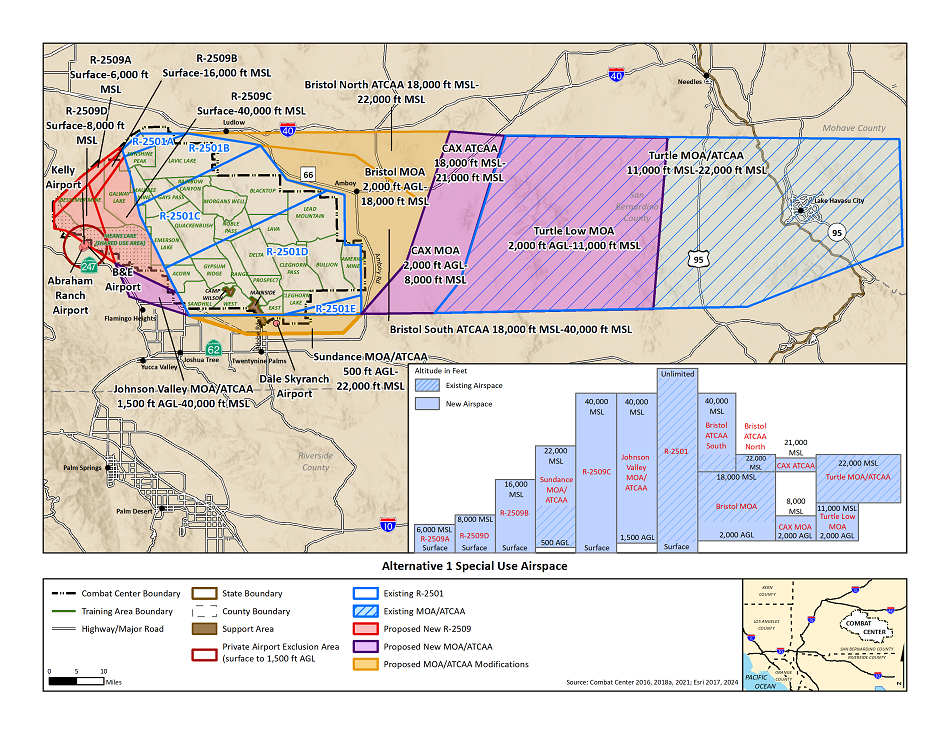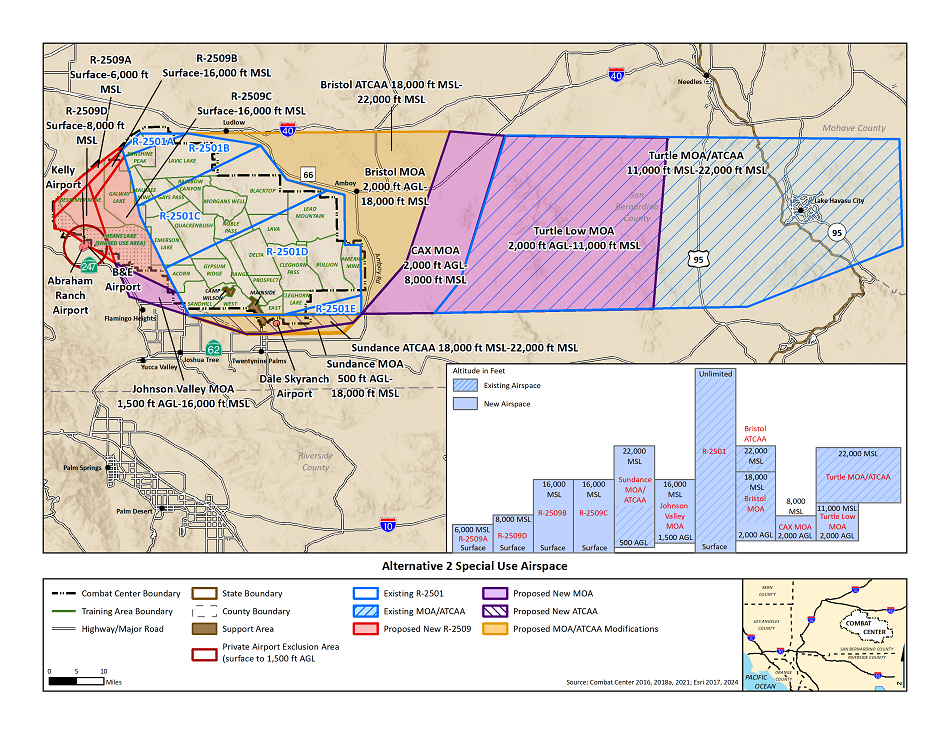About: Proposed Action & Alternatives
The United States Marine Corps (USMC) in cooperation with the Federal Aviation Administration (FAA) proposes to
establish new permanent Special Use Airspace (SUA) and to modify the lateral boundaries, component sectors, and altitude
limits within existing SUA areas, to support ongoing and future daily training activities at the Marine Air Ground Task
Force Training Command, Marine Corps Air Ground Combat Center, Twentynine Palms, California (“Combat Center”).
The FAA’s SUA program establishes/designates airspace in the interest of national defense, security, and/or welfare. SUA
is designated to ensure the safety of all users of the airspace. The types of SUAs are Restricted Areas (RAs), Military
Operations Areas (MOAs), Warning Areas, Prohibited Areas, Alert Areas, Controlled Firing Areas, and National Security
Areas. In addition to SUA, there is often an Air Traffic Control Assigned Airspace (ATCAA) from Flight Level 180 through
Flight Level 600 (18,000 to 60,000 feet above mean sea level [MSL]) in which Air Traffic Control (ATC) plans for
military operations. The RAs, MOAs, and ATCAAs are the only type of airspace discussed in detail and analyzed in the EA.
Purpose and Need for the Proposed Action
The purpose of this Proposed Action is to provide permanent SUA above and adjacent to the Combat Center to support
current and future training activities 365 days per year. The Proposed Action is needed to increase safety while
adequately supporting the training operations conducted in accordance with Marine Corps Order 3502.6, Marine Corps Force
Generation Process; USMC Force Design 2030 (March 2020, with annual updates); and Combat Center Order 3500.16A, Service
Level Training Exercise Order (May 14, 2020).
Proposed Action
Under the Proposed Action, current aircraft operations at the Combat Center would spread out across existing SUA and
expand into the newly established/modified RA, MOAs, and ATCAAs. The current number of annual sorties flown at the
Combat Center would increase by 120 annual sorties of KC-130, 20 annual sorties of Joint Aerial Refueling, and 1,599
annual sorties of Unmanned Aerial Systems (UAS). Also, 320 F-35 sorties would replace 320 FA-18 sorties (i.e., no net
change in these sorties).
There would be no change to the public’s access to the Johnson Valley Shared Use Area (also known as the Means Lake
Training Area). As a "shared use" area, the area will continue to be managed to accommodate both military training needs and public
recreational access. Military training is authorized for up to two, non-consecutive, 30-day periods annually, ensuring
the area is primarily available for public recreation.
Two alternatives for implementing the Proposed Action and the No-Action Alternative are analyzed in this EA; these
alternatives are summarized below.
Alternative 1
Similar to what was proposed in the 2012 Final Land Acquisition/Airspace Establishment Environmental Impact Statement
(EIS), Alternative 1 would establish new permanent SUA (R-2509, Johnson Valley MOA/ATCAA, Sundance ATCAA, CAX MOA/ATCAA,
and Turtle Low MOA) within the footprint presented in the 2012 Final EIS and modify existing SUA (Bristol MOA/ATCAA and
Sundance MOA) in the airspace located above, adjacent to, and to the east of the Combat Center (Figure 1). The
establishment of R-2509 and Johnson Valley MOA/ATCAA would require a minor amendment to the existing R-2501 to avoid
infringement on R-2501D.
Alternative 2 (Preferred Alternative)
Alternative 2 would also establish new permanent SUA (R-2509, Johnson Valley MOA, Sundance ATCAA, CAX MOA, and Turtle
Low MOA) and modify existing SUA (Bristol MOA/ATCAA and Sundance MOA) in the airspace located above, adjacent to, and to
the east of the Combat Center (Figure 2). The establishment of R-2509 and Johnson Valley MOA would require the same
minor amendment to the existing R-2501 to avoid infringement on R-2501D as described under Alternative 1.
Alternative 2 airspace configurations would differ from Alternative 1 in the following ways:
- Limiting altitudes to 16,000 feet MSL in R-2509C and Johnson Valley MOA.
- Not creating a Johnson Valley ATCAA or CAX ATCAA.
- Limiting altitudes in Bristol ATCAA to FL220 (same as existing airspace) and not dividing into Bristol North ATCAA and
Bristol South ATCAA.
- Modifying the southern boundary of Sundance ATCAA.
Live-fire, use of ordnance, and all ground-based training activities at the Combat Center were fully analyzed in the
2012 Final Land Acquisition/Airspace Establishment EIS, and revalidated in the 2023 Ongoing Training
Supplemental EA. The proposed changes to the aircraft operations and RA would not affect other elements of ongoing training operations, such as the use of existing impact areas, aircraft integration with
ground-based training, and use of ordnance – including how air-to-ground ordnance is delivered. Because of this and the fact that there have not been any significant changes to training operations since the 2012
Final Land Acquisition/Airspace Establishment EIS, live-fire, use of ordnance, and all ground-based training activities are not further addressed in
the EA as part of this action. However, the cumulative effects of all ongoing training operations are considered.
Click on the images below to open a full-size version


No-Action Alternative
The No-Action Alternative would make no changes to existing permanent airspace in the vicinity of the Combat Center.
Under the No-Action Alternative, the existing airspace would continue to support ongoing training but there would be no
improvement to existing airspace management, coordination, and flight safety at the Combat Center.